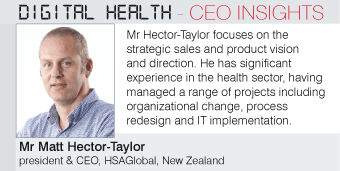
The present goal of healthcare providers is to stay connected and work together to provide the right care, in the right place, at the right time for patients

Health systems around the Asia-Pacific region and beyond are under pressure from the increasing demands of an aging population and rising rates of chronic illness. Many are responding with an emphasis on connecting the continuum of care for these patients. Regardless of cultural and organizational differences between Asia-Pacific health systems, HSAGlobal's experience in multiple countries has identified some common themes and best practices that can be shared universally.
Different countries' health systems use varying terminology to describe 'connected care'. These terms include shared care, collaborative care, integrated care, co-ordinated care and case management. Despite these variations in name, the underlying principles remain the same.
The goal is that healthcare providers are connected across different settings so that they can work together to provide the right care, in the right place, at the right time for patients. In this model, duplication is removed, care is provided proactively, patients and their support groups are actively involved and care can be provided in lower-cost settings. Expensive hospital admissions can be avoided. Digital technology, mobile devices and software now enable a degree of collaboration that has not been possible previously.
In practice, this can be as simple as enabling two clinicians working in different organizations who care for the same patient to both view and change the patient's record and plan. On a much larger scale, primary, secondary and community care providers can jointly create a shared care plan, communicate with each other and provide input into the plan when they see the patient. HSAGlobal is in the privileged position of working in several health systems across the Asia-Pacific to enable connected care initiatives.
In Singapore, HSAGlobal is working with the Singapore Agency for Integrated Care (AIC) on several Advance Care Plan projects using its Collaborative Care Management Solution (CCMS) as a common IT platform. Individuals, their healthcare providers and their family will be able to together create a plan for future health care, which can be viewed by all when needed. In Canterbury, New Zealand, the loss of 741 beds after a number of significant earthquakes accelerated the need for the Canterbury District Health Board to reduce hospital admissions, as those beds physically no longer existed. Rather than a generic programme for all patients, several initiatives for specific patient groups with long-term or complex needs were introduced. These well-targeted programs allowed for close reporting, specific change management resourcing and even changes to the funding model to incentivize all healthcare providers to engage.
CREST is a community-based rehabilitative supported discharge and admission avoidance service for older people in Christchurch. HSAGlobal's CCMS platform enables staff from Older Persons Health Specialist Services, community based care providers, general practitioners and allied health professionals to collaborate in caring for patients at home for up to six weeks.
The CCMS platform has recently been extended to include Acute Plans for patients who use acute services frequently or are at risk of sudden deterioration of their health problems. These plans can be updated by any clinician involved in the patient's care and provide valuable information when the patient presents at the emergency department or after-hours clinic. Patients with chronic obstructive pulmonary disease and heart failure, another high usage group, also have a program. In Australia, CCMS has been used in a different care setting - early childhood and parenting support. The Tweddle and Queen Elizabeth Early Parenting Centres in Melbourne manage residential and community-based support service programs for vulnerable families. The ability for a number of care providers to share a patient record, collaborate on a plan and communicate with each other has significantly improved the level of care and led to cost savings.
Shared care in action
New Zealand's National Shared Care Pilot provides a useful case study of how each health professional engages with Connected Care. As is common in many countries, in New Zealand people with long-term health conditions consume a major proportion of healthcare funds. The National Health IT Board has piloted new approaches to shared care management for people with long-term conditions with a select group of health professionals in the Auckland region for over a year. The objective is to improve the journey for people living with long-term conditions through patient participation, effective teamwork between the many services delivering their health care, and support for people to manage their conditions at home.
One patient enrolled in the pilot, Mr Mani Kant, has long standing and untreated hypertension which damaged his heart and he suffers from heart failure. His regular doctor, Dr Neil Hefford at the Grey Lynn Family Medical Centre, enrolled selected Mr Mani into the shared care system directly from his existing Practice Management System. During an initial consult Dr Hefford and Mr Mani worked together to identify his main health concerns and create a plan for managing these. The plan includes goals, actions and self-management activities that the patient and practice team undertake to help manage his condition.
Cardiologists at the Auckland Hospital Heart Failure Service, a community Heart Failure Nurse Practitioner and his local community pharmacist are also part of Mr Mani's care team. In future, other health care professionals, such as a dietician, may be involved. Everyone involved in Mr Mani's care can access his record, view his 12-month care plan, request advice or services from other care team members, record notes, assessments and measurements and review and update his medications. Any changes or updates are shared with the whole care team. Members of the team can use the system to manage referrals, undertake virtual consultations, discuss Mr Mani's care with each other or allocate tasks to other team members. Mr Mani himself can also access it and reports being much more engaged with his own health status.
Janet Callender, a Practice Nurse at Grey Lynn Medical Centre, views this immediate sharing of information as vital in providing better care to her patients. As well as the time savings that are made by not having to repeat patient information, redo tests or search for historical data, the shared care system improves productivity through electronic 'service requests' between the various members of the care team. It also allows for virtual consults to take place with a wider care team and the care plan to be amended quickly. Referrals to the Heart Failure Service may not be necessary to gain their input into the plan.
The proactive approach focuses on the health of the person over time, not just on the problem they present with at ER. If a patient that is part of the Shared Care Pilot ends up in hospital with an acute episode, hospital staff can access their care plan. This means that they can confidently treat the patient in the acute setting knowing their goals and care plan, baseline measurements, current medications and care team details. Information about the hospital visit is also shared automatically with the care team so that the care plan can be adapted if necessary.
Helen McGrinder, the community Heart Failure Nurse Practitioner reports that when patients with a shared care plan do end up in hospital, it is often for a much shorter time as their condition is being better managed overall. To date Mr Mani has not had an acute presentation at hospital, and the goal is for him to be able to continue living an active lifestyle, enjoying time with his grandchildren and in his garden.
Some lessons
In all of these cases, the CCMS solution is an enabling platform for care collaboration across organization and physical boundaries. Connected care is a significant transformative step for many health systems, particularly when compared to the traditional approach where highly specialized providers operate in their own 'silos'. In order for change to be implemented effectively, each health provider along the continuum of care - as well as the patient - must experience benefits. Otherwise costs and workloads are merely being moved from one part of the health system to another.
One theme emerging from these various implementations is that the technology is only a part of what is required to be successful. Change management, service redesign, rethinking roles and responsibilities, and even structural and funding system changes are critical to successful implementations. However, as these examples demonstrate connected care is not only possible but effective. Small projects provide big lessons and signpost the path towards more mainstream adoption.




